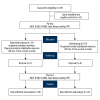Effects of a Progressive Stabilization Exercise Program Using Respiratory Resistance for Patients with Lumbar Instability: A Randomized Controlled Trial
- PMID: 30842392
- PMCID: PMC6417147
- DOI: 10.12659/MSM.913036
Effects of a Progressive Stabilization Exercise Program Using Respiratory Resistance for Patients with Lumbar Instability: A Randomized Controlled Trial
Abstract
BACKGROUND This study investigated the effects of progressive stabilization exercise program carried out with respiratory resistance in patients with lumbar instability. MATERIAL AND METHODS Forty-three patients with lumbar instability were randomly assigned to experimental (n=20) and control groups (n=23). The experimental group performed progressive lumbar stabilization exercises along with respiratory resistance, and the control group only performed progressive lumbar stabilization exercises, for 40 min per session, 3 sessions a week, for 4 weeks. Numeric rating scale (NRS), Korean-Oswestry disability index (K-ODI), static balance ability, Fear-Avoidance Beliefs Questionnaire (FABQ), and pulmonary function test (PFT) were performed before and after the intervention program for comparison. RESULTS The 2 groups showed significant differences in NRS, K-ODI, balance ability, and FABQ after the interventions (p<0.05), but greater improvements were shown by the experimental group in balance ability and FABQ values. PFT results in the experimental group showed a significant increase (p<0.05) in forced vital capacity (FVC), forced expiratory volume in 1 second (FEV1), and maximum voluntary ventilation (MVV). The experimental group showed a greater improvement (p<0.05) in FVC and MVV compared to the control group. CONCLUSIONS Progressive stabilization exercise program with respiratory resistance is an effective method with clinical significance in pain reduction, psychosocial stability, and enhancement of motor and respiratory functions.
Figures
References
-
- Morrow LJ, Smith S. The management of lower back pain. J R Nav Med Serv. 2014;100:282–87. - PubMed
-
- Skoffer B. Low back pain in 15- to 16-year-old children in relation to school furniture and carrying of the school bag. Spine (Phila Pa 1976) 2007;32:E713–17. - PubMed
-
- O’sullivan PB, Burnett A, Floyd AN, et al. Lumbar repositioning deficit in a specific low back pain population. Spine (Phila Pa 1976) 2003;28:1074–79. - PubMed
-
- Adams MA, Roughley PJ. What is intervertebral disc degeneration, and what causes it? Spine (Phila Pa 1976) 2006;31:2151–61. - PubMed
Publication types
MeSH terms
LinkOut - more resources
Full Text Sources



